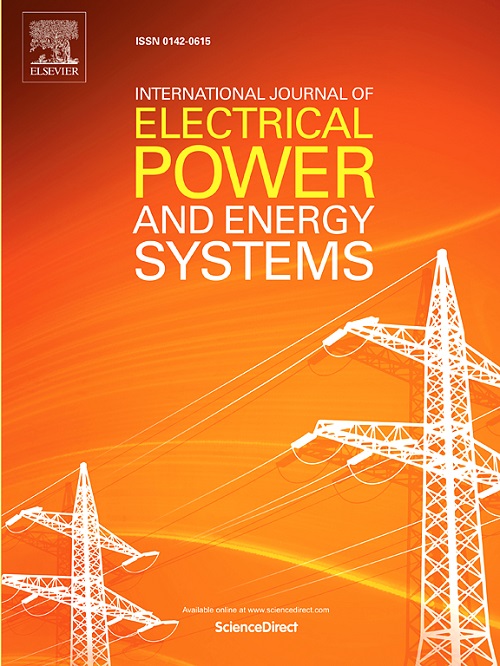Risk-averse operation of microgrids in distribution systems with price-responsive demands
IF 5
2区 工程技术
Q1 ENGINEERING, ELECTRICAL & ELECTRONIC
International Journal of Electrical Power & Energy Systems
Pub Date : 2025-04-25
DOI:10.1016/j.ijepes.2025.110581
引用次数: 0
Abstract
This paper introduces a decentralized, risk-averse operational framework for interconnected, unbalanced microgrids and the distribution system. Distribution system operation is modeled as a risk-averse optimization problem using conditional value-at-risk measures to enhance robustness against uncertainties in price-responsive demand bids. Microgrid operations are structured as scenario-based robust optimization problems, capturing the worst-case scenarios for demand and solar PV generation. Non-convex energy management problems within the distribution system and microgrids are reformulated as convex optimization problems using the moment relaxation technique. A decentralized scheme addresses heterogeneous uncertainties in microgrids and the distribution system. The framework is applied to two case studies: a distribution system connected to two microgrids and a modified IEEE 123-bus distribution system connected to four microgrids. The risk-averse optimization solution is compared to that of a stochastic programming approach. For the IEEE 123-bus system, the results show that introducing risk aversion decreases social welfare by 44.63% compared to the risk-neutral solution but improves the conditional value-at-risk by 44.04%. Additionally, the impacts of dispatchable resources, including energy storage and distributed generation, on operation cost, phase balancing, and uncertainty control at the main feeder are examined. It is shown that incorporating a statistical distance metric to regulate power flow at the main feeder decreases social welfare by 6.48%.
具有价格响应需求的配电系统中微电网的风险规避操作
本文介绍了一个分散的,风险规避的操作框架,互联的,不平衡的微电网和配电系统。本文将配电系统运行建模为一个风险规避优化问题,使用有条件的风险价值度量来增强对价格响应需求投标不确定性的鲁棒性。微电网运行被构建为基于场景的稳健优化问题,捕捉需求和太阳能光伏发电的最坏情况。利用矩松弛技术将配电系统和微电网中的非凸能量管理问题重新表述为凸优化问题。分散式方案解决了微电网和配电系统中的异构不确定性。该框架应用于两个案例研究:连接到两个微电网的配电系统和连接到四个微电网的改进的IEEE 123总线配电系统。将风险规避优化解与随机规划方法的优化解进行了比较。对于IEEE 123总线系统,结果表明,与风险中性解决方案相比,引入风险规避使社会福利降低了44.63%,但使条件风险值提高了44.04%。此外,研究了可调度资源(包括储能和分布式发电)对主馈线运行成本、相位平衡和不确定性控制的影响。研究表明,采用统计距离度量来调节主馈线的潮流会使社会福利降低6.48%。
本文章由计算机程序翻译,如有差异,请以英文原文为准。
求助全文
约1分钟内获得全文
求助全文
来源期刊
CiteScore
12.10
自引率
17.30%
发文量
1022
审稿时长
51 days
期刊介绍:
The journal covers theoretical developments in electrical power and energy systems and their applications. The coverage embraces: generation and network planning; reliability; long and short term operation; expert systems; neural networks; object oriented systems; system control centres; database and information systems; stock and parameter estimation; system security and adequacy; network theory, modelling and computation; small and large system dynamics; dynamic model identification; on-line control including load and switching control; protection; distribution systems; energy economics; impact of non-conventional systems; and man-machine interfaces.
As well as original research papers, the journal publishes short contributions, book reviews and conference reports. All papers are peer-reviewed by at least two referees.

 求助内容:
求助内容: 应助结果提醒方式:
应助结果提醒方式:


